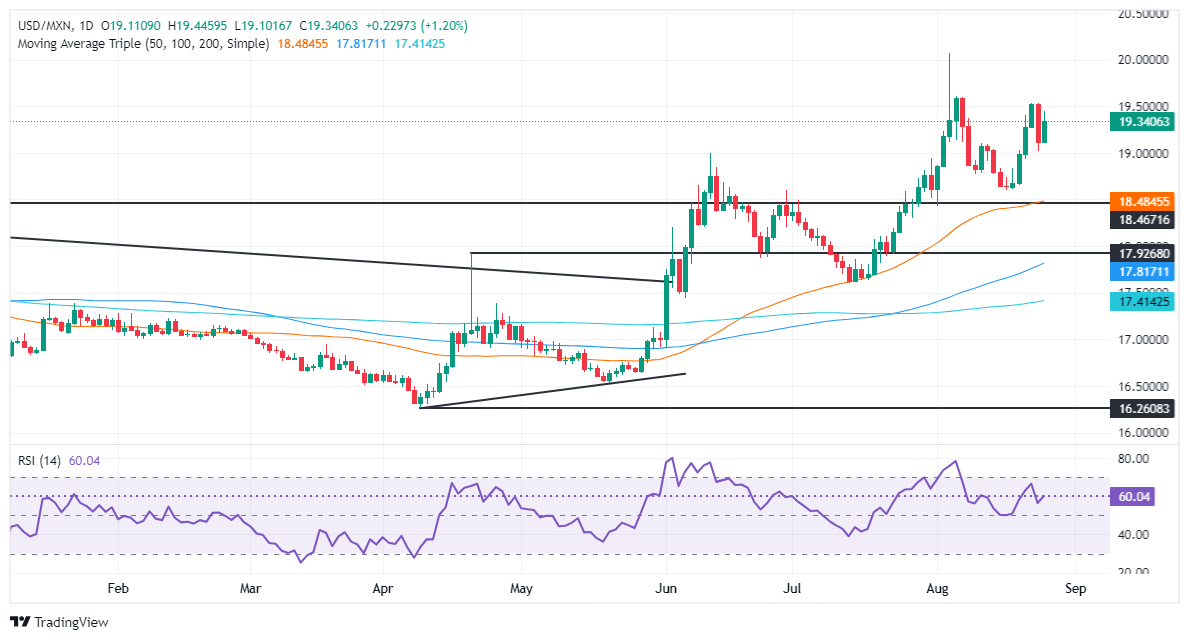Mexican Peso slumps over judiciary reforms and Banxico’s dovish tone

- Mexican Peso slips as investors worry about the potential approval of controversial judiciary reforms, which could increase political risks.
- Morena’s supermajority in Congress heightens fears of constitutional changes, leading to greater concentration of power and higher risk premiums.
- Dovish comments from Banxico Deputy Governor Galia Borja add pressure.
The Mexican Peso begins the week on the back foot, reversing most of last Friday’s gains. Losses of over 1.80% are seen in the Peso amid fears that the Mexican Congress could approve the Judiciary Reform bill and dovish comments from Deputy Governor Galia Borja. At the time of writing, the USD/MXN trades at 19.42 after bouncing off a daily low of 19.08.
Last Friday, the Instituto Nacional Electoral (INE) approved the Morena ruling party’s supermajority in the Mexican Congress, raising investors’ concerns that approving controversial changes to the Mexican Constitution could increase the country’s risks.
This is one of Monday’s main drivers of USD/MXN price action. Now that Morena controls the lower house, the risks of the judiciary reform being approved have heightened, weighing on the Mexican Peso. Some analysts cited by El Financiero asserted that constitutional changes could lead to a greater concentration of power in the executive and impact the state of law.
Last week, Morgan Stanley recommended to its clients not to invest in shares in Mexico, citing fears that the judiciary reform could increase risk premiums in the country.
On Monday, Bank of Mexico Deputy Governor Galia Borja was interviewed by El Economista. She said that since June’s decision when the Governing Council left rates unchanged at 11.00%, they already had some elements about an economic slowdown in the second quarter.
“In the August decision, it was confirmed that economic activity was weakening compared to what we expected, which was effectively confirmed with the GDP data for the 2nd quarter,” said Borja.
She said that March and August rate cuts do not imply the abandonment of restrictive policy. Borja added that “the fact that we are adjusting it as has happened in March and August (of 2024) does not mean that we are going to the neutral or accommodative territory. That will take some time. So, from now on, there will still be another period in which the restrictive monetary stance will continue.”
Mexico’s economic docket will remain light. The Balance of Trade is expected to be released on August 27.
Across the border, Federal Reserve (Fed) Chair Jerome Powell, giving the green light last week to begin easing monetary policy, hurt the Greenback against most G7 FX currencies. Nevertheless, the US Dollar has gained some ground against the emerging market Mexican Peso.
Daily digest market movers: Mexican Peso depreciates also on geopolitical risks
- Another driver that weakened the Peso was the escalation of the Israel-Hezbollah conflict in the Middle East.
- Mexico’s Balance of Trade is expected to show a deficit of $-1.47 billion in July, wider than June’s $-1.03 billion.
- Traders will eye the release of US Conference Board Consumer Confidence for August, Fed speakers, the release of Q2’s 2024 GDP, and the Fed’s preferred inflation gauge, the Core Personal Consumption Expenditures Price Index (PCE).
- Data from the Chicago Board of Trade (CBOT) suggests the Fed will cut at least 97 basis points (bps) according to the fed funds rate futures contract for December 2024.
Technical outlook: Mexican Peso weakens as USD/MXN jumps above 19.30
The USD/MXN daily chart suggests the uptrend remains intact, though buyers need to lift the exchange rate above last week’s peak at 19.53, which could exacerbate a rally to the 20.00 psychological figure. If those levels are cleared, the next stop would be the year-to-date (YTD) high at 20.22.
Conversely, if USD/MXN tumbles below 19.00, this could pave the way for a leg-down. The first support would be the August 19 low of 18.59, followed by the 50-day Simple Moving Average (SMA) at 18.48.
Banxico FAQs
The Bank of Mexico, also known as Banxico, is the country’s central bank. Its mission is to preserve the value of Mexico’s currency, the Mexican Peso (MXN), and to set the monetary policy. To this end, its main objective is to maintain low and stable inflation within target levels – at or close to its target of 3%, the midpoint in a tolerance band of between 2% and 4%.
The main tool of the Banxico to guide monetary policy is by setting interest rates. When inflation is above target, the bank will attempt to tame it by raising rates, making it more expensive for households and businesses to borrow money and thus cooling the economy. Higher interest rates are generally positive for the Mexican Peso (MXN) as they lead to higher yields, making the country a more attractive place for investors. On the contrary, lower interest rates tend to weaken MXN. The rate differential with the USD, or how the Banxico is expected to set interest rates compared with the US Federal Reserve (Fed), is a key factor.
Banxico meets eight times a year, and its monetary policy is greatly influenced by decisions of the US Federal Reserve (Fed). Therefore, the central bank’s decision-making committee usually gathers a week after the Fed. In doing so, Banxico reacts and sometimes anticipates monetary policy measures set by the Federal Reserve. For example, after the Covid-19 pandemic, before the Fed raised rates, Banxico did it first in an attempt to diminish the chances of a substantial depreciation of the Mexican Peso (MXN) and to prevent capital outflows that could destabilize the country.
